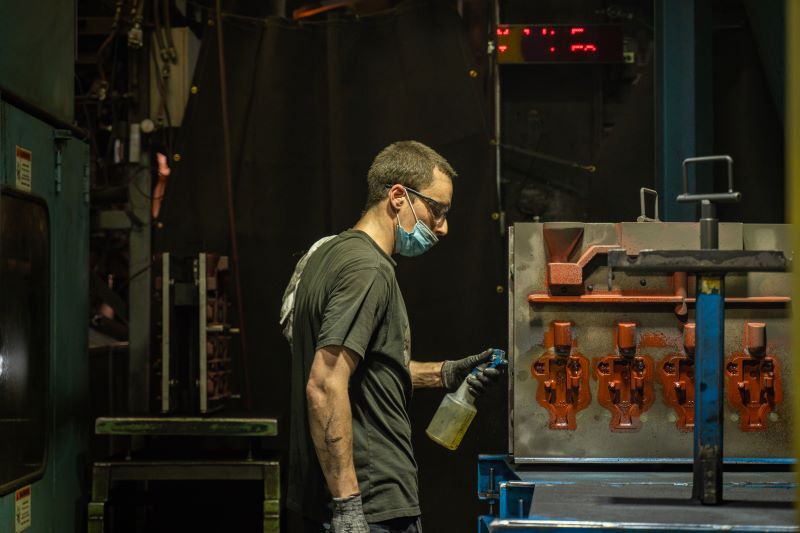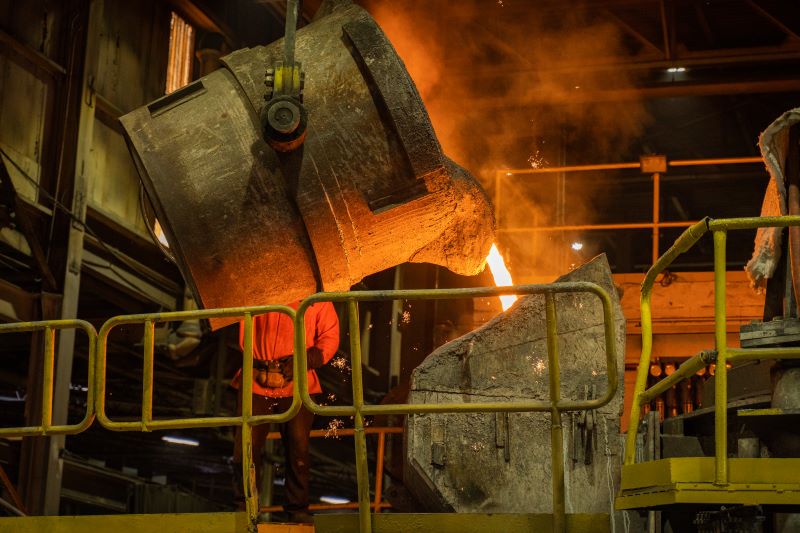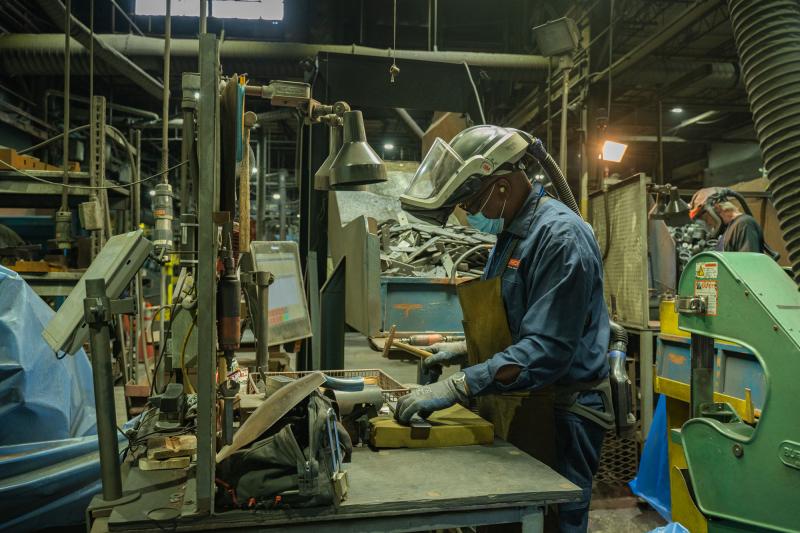Why are we so sure you're getting the very best ductile iron castings when you order from Urick?
Our last blog covered how Urick achieves enviable casting quality through what we put into our ductile iron. But, how do we test and prove that quality in finished products? Find out!
In this post, we're highlighting various destructive and nondestructive tests a ductile iron foundry can use to check casting quality. Saving the best for last, we'll give you an overview of resonant frequency testing and why we use it to test every part we cast.
Casting inspection methods

The various methods for testing ductile iron castings fall into two broad categories: destructive testing and nondestructive testing. Let's take a close look at each one.
Destructive testing
Destructive testing is carried out to analyze the point at which a sample of the material or a component made from it fails. These tests deform or destroy a material to find out how it performs under different loads and determine its limits in terms of toughness, strength, flexibility, and hardness.
Here are five common destructive testing methods.
1. Hardness test
Several types of hardness tests exist. These include scratch hardness tests that determine how well a material resists scratching or abrasion. There are also indentation hardness tests used to measure the material's resistance to indentation from a sharp object.
The amount of force required to produce scratches and indents, as well as the depth and size of the scratches and indents produced are all taken into consideration.
2. Tensile test
These tests subject the specimen to stretching forces to determine the force needed to break it. Measures of elongation and reduction in area at the site of the break are also evaluated. These help engineers determine factors such as the material's tensile strength, maximum elongation, and breaking strength.
Tensile testing is most often done using a universal testing machine, also called a tensometer. This machine can also test the compressive strength of the specimen.
3. Bend test
This test of a material's ductility involves bending a sample of the material to a predetermined angle or the point of destruction. Cracks and defects caused by bending can be seen through visual inspection. The test also allows you to measure the material's modulus of elasticity, flexural strength, and deflection at fracture.
As you can imagine, ductile cast iron performs very well on this kind of test when compared to the performance of its more brittle counterpart, gray cast iron.
4. Corrosion test
Ductile iron is known for its superior corrosion resistance, which contributes to its overall durability compared to cast iron. This, in turn, makes it more suitable for high-demand applications. However, it still requires thorough testing, namely because any form of corrosion can negatively impact the tensile strength and longevity of a component.
Corrosion testing evaluates how a material responds to corrosive substances and environments. Causes of corrosion range from humidity and salinity to harmful gasses and chemicals — such as carbon dioxide and hydrogen sulfide.
Signs of corrosion, rate of corrosion, and the effect of corrosion on performance are among the things looked at. These tests may also look at the effectiveness of different types of corrosion protection for the material.
5. Chemical analysis
The chemical makeup of the material can be tested by grinding or vaporizing a sample of it and testing for the proportions of various elements in it.
Chemical analysis may take the form of more traditional wet chemical methods, such as observing how the powdered material reacts with other chemicals. Modern chemical analysis methods focus more on the use of instruments (i.e. spectroscopy) to analyze the vaporized material.
What are the advantages and disadvantages of destructive testing?
While each destructive testing method will have its own unique set of advantages and disadvantages, there are some general pros and cons shared by this group of tests.
Pros of destructive testing
- Used to test both physical and chemical properties of the specimen.
- Can be done to specific standards or designed to replicate the service conditions in which the component will be used.
- Comes in a variety of methods.
- Very useful for testing the engineering and design of a specimen.
- Ideal for initial testing of an item that is to be mass-produced.
Cons of destructive testing
- Items cannot be put to normal use after testing.
- Typically more expensive than nondestructive testing.
- Typically more time-consuming than nondestructive testing.
- Potentially dangerous to the tester due to the equipment used.
Nondestructive testing
This category of inspection methods helps to determine the integrity of ductile iron castings without causing damage to the specimen. Two or more of the tests are often used to ensure a more complete inspection of a casting's quality.
Here are six common nondestructive testing methods.
1. Visual inspection
This is the oldest method of inspection, requiring only the eyes of the inspector. Visual inspection may be used as a means of quality control. Imperfections, such as distortions, cracking, and voids in a casting, may be picked up by careful visual inspection.
2. Eddy current testing
This method of nondestructive testing may be used on electrically conductive ferrous and non-ferrous castings. It uses AC current to create a magnetic field which induces a low-energy electrical current in the casting. In response, the casting generates a magnetic field which interacts with the original field. Discontinuities affect the interaction and this can be analyzed by electronic equipment.
Eddy current testing can be used to detect minute flaws surface and internal flaws. It can also be used as a thickness gauge and to test the conductivity of a specimen. However, training and experience are necessary to use the equipment and interpret the results accurately.
3. Magnetic particle inspection
Like other alloys of iron, ductile iron is a ferromagnetic material. This allows for the use of magnetic particle inspection to check for surface and shallow subsurface discontinuities in ductile iron casting. As one ISO standard for magnetic particle testing warns, however, the test's "sensitivity diminishes rapidly with depth." Also, non-ferrous materials cannot be tested using this method.
The process typically involves the use of an electric current to magnetize (put a magnetic field into) the casting. Cracks or other discontinuities in the casting will disrupt the magnetic field and attract iron filings that are applied to it. Accumulations of the particles are called indications. Once these are located, the discontinuities are evaluated and the casting is demagnetized.
4. Penetrant testing
This process uses either visible or fluorescent penetrants to test for discontinuities in both ferrous and non-ferrous castings. The part to be inspected is first thoroughly cleaned of dirt, oil, paint, etc. This allows for free passage of the penetrant into any discontinuities. The test can be used to detect surface cracks, leaks, and surface porosity.
The penetrant is allowed to soak for a predetermined length of time before any excess is removed and a developer applied. Inspection is then done with the naked eye when using visible penetrants but an ultraviolet light is needed to inspect the casting when a fluorescent penetrant is applied. The fluorescent penetrant has the advantage of allowing you to detect much finer discontinuities in the casting.
6. Radiographic testing
Radiation in the form of x-rays or gamma rays is passed through the casting. Discontinuities within the casting affect how much radiation is absorbed and how much makes it through to be captured by the detector. An image of the internal structure of the casting is formed on the detector. The resulting image may be 2D or 3D. It may also be static or, depending on the equipment used, it may be viewed in near real-time.
Radiographic testing can be used to conduct internal, volumetric (or whole body) inspection of the casting.
6. Ultrasonic testing
This inspection method uses high-frequency sound waves that are inaudible to the human ear. It can be used on ferrous and nonferrous castings to determine their thickness, as well as to conduct an internal, volumetric inspection of the castings.
An ultrasonic transducer is used to create sound waves which are pulsed through the casting. In one method of testing the reflected sound waves or echo is analyzed. In another, it is the sound waves received at the other end of the casting that are analyzed.
What are the advantages and disadvantages of nondestructive testing?
There are quite a few advantages to using nondestructive tests but their downsides should also be taken into consideration.
Pros of nondestructive testing
- Typically used to find defects in a specimen.
- Generally simple and safe methods of inspection.
- Saves time and money in product evaluation.
- Can be used to detect internal and surface flaws.
- Does not damage or destroy the specimen.
- The specimen (once not found to be defective) can be put to normal use after testing.
- Can be used to spot early signs of deterioration in parts that are already at work in the field.
- Can be conducted without equipment downtime and disruption to workflow.
- Very useful for maintenance teams in preventing equipment failure.
Cons of nondestructive testing
- Electricity is required for some testing methods.
- Specimen conductivity, magnetic permeability, porosity, and finish may affect the effectiveness of some tests.
- Some of the required testing equipment might be expensive.
What is resonant frequency testing?
Resonant frequency testing is a kind of non-destructive testing that uses sound to inspect castings. All objects have a natural resonant frequency at which they vibrate. Identical tuning forks, for example, share the same resonant frequency and will vibrate or ring at the same consistent pitch. So, too, will identical ductile iron castings.
This resonant frequency is a measurable quality. It can be analyzed to determine whether the part being inspected vibrates in the same predetermined manner as a good sample of the casting does. Testing this way allows you to carry out a volumetric inspection of a casting to check its nodularity, as we mentioned earlier.
Plus, part preparation is not required for the test to be carried out and an entire casting can be fully inspected in seconds, allowing for accurate, automated, high-speed inspection of ductile iron castings. Testing every ductile cast iron part we manufacture here at Urick would probably be a logistics nightmare if we did not rely on resonant frequency testing.
Urick has been using resonant frequency testing to inspect all of its castings since 2005. Our Foundry Director, Dan Mayton, and Quality Control Manager, Mark Sullivan spoke in great detail about how Urick applies resonant frequency testing in this The Modal Shop blog post.
Guaranteed quality with Urick

Ductile is all about the details - Urick has those down and we ensure it with thorough testing of our products. As a part of the Emerson Company, manufacturing items with unmatched quality and precision is in our DNA. You can trust Urick Foundry to design, produce, test, and deliver exactly the ductile iron castings you require. Contact us today!



